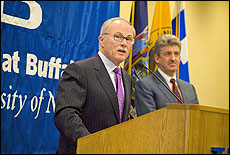Archives
Spitzer endorses UB 2020
Designates UB as a SUNY flagship institution
By SUE WUETCHER
Reporter Editor
Gov. Eliot Spitzer yesterday endorsed UB 2020, the university's strategic plan designed to transform UB into a model 21st century public research university.

President John B. Simpson (left)
and David Dunn, vice president for health sciences, take questions from
journalists at a press conference following Gov. Eliot Spitzer's State
of the State address.
PHOTO: DOUGLAS LEVERE
Spitzer, in his second annual State of the State address, also designated UB as a flagship institution of the SUNY system and proposed the development of a new downtown campus designed specifically for health sciences units that would be home to more than 7,000 faculty staff and students.
"We will move forward on the University at Buffalo's 2020 expansion as a centerpiece of our strategy to reinvigorate the economy of Western New York," Spitzer said in his address in Albany. "UB will become an economic engine for Buffalo, and a flagship institution for a world-class, public university system."
Spitzer noted that UB's total student population will grow from 29,000 to almost 41,000, and more than 7,000 students, faculty and staff will work and study on a new downtown campus for medicine and health sciences.
The governor's public support of UB 2020 comes on the heels of efforts by President John B. Simpson, UB Council Chair Jeremy M. Jacobs and other UB administrators to emphasize to the governor and his senior staff the message that a thriving UB is the best agent for the economic revitalization of Western New York.
Spitzer's remarks in the State of the State address outline "a bold investment for the State of New York that will help the University at Buffalo achieve the goals we have set forth for ourselves with UB 2020," Simpson said at a press conference held in Capen Hall shortly after the governor's address.
"This investment can bring about a major transformation, not only here at UB, but I think more broadly within our community because of the important role-the significant role-that the university has in the Western New York community," Simpson said. "It will lead to the creation of the three vibrant campuses of UB that we've been discussing now for many months. I'm genuinely thankful for the governor's leadership in getting to this point. He should know that the entire university is ready to respond in line with the vision he has laid out today."
Simpson said the governor's recognition of UB "is really a recognition of the wonderful faculty and staff and students who we have here. They are UB."
"They are as committed as I am to building a great partnership between our university and our community, a partnership that can help produce an era of economic recovery in Western New York and contribute, therefore, to a positive way to a bright future for all our children," he said.
Moreover, nearly 4,000 individuals have joined UB Believers, the broad-based advocacy group that has been created to help support UB 2020, Simpson noted. "We also asked the governor to believe in UB, and he has now responded with an equally strong commitment. We are grateful that he has become such a big UB Believer," he said.
Simpson added that UB 2020 also has the "unanimous and strong support" of the Western New York legislative delegation.
In proposing a new downtown campus for the health sciences, Spitzer "has called for a very bold vision of how our downtown presence might look," Simpson pointed out. The governor had asked UB administrators months ago to "think boldly" about the future of the university and that a number of scenarios had been drawn up, including further developing UB's downtown presence into a biomedical sciences/health sciences campus, Simpson explained.
"We put together ideas about how this might occur, recognizing that we are in the midst of a long-term capital master planning process," he said, calling the scenarios "ideas—not firm plans that we need to put in place."
"This was something that the governor found appealing, that the governor endorses. I think it's something's that very good for the city and very good for the community as well as potentially very good for the university," he said.
How this all plays out will depend, in part, upon how the Legislature reacts to funding it, he said.
"It's a very long-term process, and there are a whole host of variables in place, including our planning process, that will determine how this will be manifest," he said. "Most importantly, I find it very exciting that the governor is interested in the kinds of things we can potentially do by a model such as this."
David L. Dunn, vice president for health sciences, said locating 7,000 faculty, staff and students downtown was "doable."
UB already is purchasing properties downtown, and has expanded the Center of Excellence in Bioinformatics and Life Sciences on the Buffalo Niagara Medical Campus, Dunn said. "We have great relationships with Hauptman-Woodward (Medical Research Institute) and Roswell (Park Cancer Institute) and other partnerships" he added. "Certainly with the reconfiguration in health care being proposed here by the Department of Health, there many things intersecting simultaneously, all of which are positive."
Simpson said he was not worried about UB receiving specific funding for UB 2020 in this year's state capital budget.
"What we have in UB 2020 is a long-term process," he said. "We are changing the way in which we think about the university's future and the way in which we relate to the State of New York that goes beyond the annual budget process into thinking over the long-term about what the university can be," he said. "And so what happens from year to year may be less important than the clear acknowledgment by the governor that what he is interested in supporting is the long-term UB 2020 vision," he said. "That makes for a very different conversation that we've had in the past."
Simpson noted that Western New York seems to be a place where plans frequently are made, but end up sitting on a shelf.
"In the case of UB, we have a plan, we are implementing it and now we have a critically important recognition of this and potential support by our colleagues in Albany as said by the governor in his State of the State address," he said. "Today is a day to be very excited, as I am, and to be very hopeful about the future of UB, and therefore about the future of Western New York."
The plan for higher education that Spitzer outlined in the State of the State address springs from recommendations released last month by the New York State Commission on Higher Education.
In addition to support of UB 2020, the governor called for the creation of a $4 billion endowment for SUNY and CUNY to hire faculty and fund research, and a $3 billion Empire State Innovation Fund to support research proposals with significant economic development promise.
He also proposed hiring an additional 2,000 full-time faculty, including 250 eminent scholars, over the next five years.

